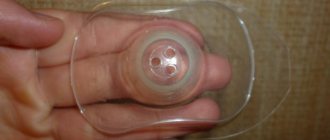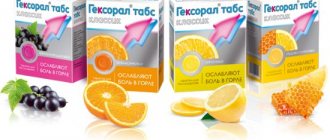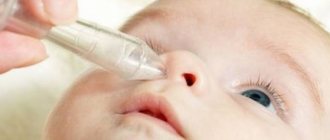Author's rating
Author of the article
Shutofedova Ksenia Yurievna
General practitioner
Articles written
578
about the author
Nasonex is a nasal spray intended for the treatment of inflammatory processes in the nasal cavity. The new drug quickly gained popularity among otorhinolaryngologists due to its unique composition. Many people are interested in the question of whether Nasonex can be used for adenoids - how reasonable and expedient this is. This article is intended to find out how suitable this drug is for the treatment of adenoid growths.
Release form
Nasonex for adenoids in children is sold in the form of a nasal spray. The drug itself is a suspension that must be sprayed into the nose using a dispenser installed on the package. This is the only form in which the medicine is available. You will not find Nasonex in tablets, capsules or dragees.
The active ingredient of the drug is mometasone furoate. This compound is a synthetic glucocorticoid hormone. The medicine is used only externally; it is introduced into the compositions of ointments, solutions, creams, lotions, and also sprays. The main effect (like any glucocorticosteroid drug) is anti-inflammatory. The most important difference from natural steroid-type drugs is the lack of absorption into the blood from the mucous membranes and skin.
Children with adenoids can be prescribed this drug due to its strengths: high efficiency and lack of generalized effects.
For adenoiditis, this is a wonderful replacement for drugs that are more expensive and less accessible, and sometimes even more dangerous (if you evaluate contraindications and side effects).
Release form of the drug.
Possible harm
Most often, the drug is well tolerated by patients and they do not have any complaints associated with its use. However, the risk of side effects cannot be ruled out.
In first place in terms of frequency of occurrence are nosebleeds. Moreover, we are talking about both the obvious discharge of blood from the nose and the appearance of nasal mucus, in which there are clots and streaks of blood.
Other side effects that may be caused by using Nasonex:
Burning sensation in the nose;
The appearance of ulcers on the nasal mucosa;
Dyspnea and bronchospasm are extremely rare;
Even less common are severe allergic reactions (angioedema and anaphylactic shock), perforation of the nasal septum and increased intracranial pressure.
During clinical trials of the drug, it was found that nosebleeds stop on their own and are not characterized by heavy discharge.
How it works
In addition to the anti-inflammatory effect, the drug has an antiallergic, vasoconstrictive and antipruritic effect.
To understand why a drug has such effects, let us consider the overall physiological role of glucocorticosteroids in the human body. Glucocorticoid hormones are produced in the cortical part of the human adrenal glands and have the following effects:
- Fighting stress and shock. The human body in a state of shock or severe stress releases large amounts of adrenal hormones. Thanks to these substances, the body quickly adapts to blood loss, a sharp decrease in pressure (shock), and injuries. The blood vessels narrow, which increases blood pressure and increases the sensitivity of heart cells to biologically active substances. The effect on hematopoietic cells promotes rapid recovery of the body after blood loss;
- Effect on general metabolism. Glucocorticosteroids help increase the concentration of blood glucose, convert amino acids into glucose, inhibit the uptake of this monosaccharide by cells, and affect the metabolism of proteins and lipids;
- Regulation of immunity. Adrenal steroid hormones have enviable activity in relation to the human immune system. It is aimed at inhibiting the functions of T and B cells, their apoptosis, as well as reducing the intensity of leukopoiesis. However, it cannot be said for sure that glucocorticoid hormones are one hundred percent immunosuppressants, since the effect depends on the concentration of the hormone. At low concentrations, T cells perform their functions more intensively;
- Anti-inflammatory effect. This is the most important thing that interests doctors and pharmacists. Glucocorticosteroid hormones reduce the activity of mediators and enzymes of inflammatory processes: proteases, nucleases, hyaluronidases, phospholipases, prostaglandins, and so on;
- Antiallergic effect. Glucocorticoids reduce the release of immunoglobulin E, the appearance of which is the cause of allergic reactions.
Anti-inflammatory and antiallergic effects are especially in demand in the treatment of adenoiditis. Treatment of adenoids with Nasonex is due to its effects and at the same time the lack of absorption of the drug into the blood. For children, the instructions for use do not regulate the treatment of adenoids, but doctors themselves often turn to such a remedy in order to eliminate the symptoms of adenoid growths.
The drug helps reduce swelling and free the child's breathing. This is especially important if the doctor considers it inappropriate or impossible to perform surgery and chooses conservative therapy.
How does Nasonex work?
Important information
The drug is practically not absorbed into the systemic circulation when used topically. This allows it to be successfully used to treat adenoids and minimize the risk of side effects. When using the drug in acceptable dosages, its substances are not detected in the blood.
An overdose of Nasonex when applied topically is practically impossible. However, if a dose is administered that significantly exceeds the specified values, then it is necessary to seek medical help and spend some time under the supervision of specialists. In general, a minor overdose of the drug is not associated with any complications.
It is not recommended to combine Nasonex with other glucocorticosteroids, as this increases the risk of side effects and can lead to suppression of adrenal function. No interactions with other drugs have been established.
When treatment of adenoids with the drug Nasonex is delayed for a long time, it is necessary that the patient’s nasal mucosa be monitored by an otolaryngologist. Although no cases of nasal tissue atrophy have been reported, the use of hormonal agents is associated with this complication.
During therapy, local immunity is suppressed. This increases the risk of upper respiratory tract infection. Therefore, the patient should minimize contact with people suffering from viral or bacterial diseases. If the patient’s body temperature rises, pain occurs on one side of the face, or a toothache bothers them, then they should consult a doctor immediately. In this case, the doctor must be informed that the person is using a hormonal drug for treatment.
If during Nasonex therapy the patient develops a mycotic infection of the nasopharynx, then the use of the drug should be discontinued.
Once opened, the medicine retains its quality for two months. Then it needs to be disposed of. If the seal of the plastic bottle has not been broken, the shelf life of the drug is 2 years.
After use, the dispenser must be closed with a cap, which will prevent dust and other contaminants from entering the bottle.
Is it prescribed for adenoids?
After removal of the adenoids, Nasonex helps eliminate the swelling that covers the nasopharynx and restore normal breathing in the child. The instructions for use (which will be discussed again later) do not list adenoiditis as an indication. But an otolaryngologist may prescribe Nasonex for symptomatic treatment.
In his releases, Komarovsky repeatedly touches on the topic of adenoids and their treatment, since almost every parent is faced with such a diagnosis in their children.
Is a remedy prescribed for adenoids?
Komarovsky's opinion
Komarovsky recommends first of all paying attention to those methods that allow you to do without surgery during the treatment process. We are talking about so-called conservative treatment. Still, the operation, although it allows you to restore natural breathing, does not protect against the appearance of adenoids in the future. But conservative treatment, organized correctly, has a much more effective and long-lasting result.
To achieve the effect using conservative methods, it is possible to use Nasonex. Only provided that the adenoids have not grown too much. That is, the drug is able to provide support in the first or second degree of the disease. But you still can’t do without additional physiotherapeutic methods.
Nasonex has a good local effect, but does not strengthen the body as a whole. Therefore, you cannot completely rely on it alone. The doctor does not consider this remedy a panacea. And parents need to take into account that without other influences it will not be possible to recover.
Instructions for use
How to spray Nasonex correctly? The instructions for the drug answer this question:
- For children from 2 to 11 years old, the drug is used 1 injection twice a day. Thus, the dosage is only 100 micrograms per day;
- From the age of 12, the portion is doubled - the child is given 2 injections twice a day. But sometimes the doctor may find it necessary to administer a larger dose - up to 400 micrograms per day. Experts also prescribe the drug as an inhalation to deliver the active substance further along the respiratory tract.
For adenoids in children, the dosages are still the same. The doctor draws up an individual treatment plan.
Reviews from parents about spray treatment
Nasonex did not suit my daughter; on the contrary, the swelling began even worse. ENT called the representatives of this medicine, they said - remove it. Sometimes it happens. Now we take Flixonase and there is an improvement.
Olesya
https://vladmama.ru/forum/viewtopic.php?f=1103&t=75754&start=80
It really helps us, but we have grade 1 adenoids - they have hardly shrunk, but the runny nose went away already on the 2nd day. His daughter is 2 months old. prescribed 1 spray per day.
Anna
https://www.u-mama.ru/forum/kids/child-health/548439/index.html
After the acute phase, one ENT specialist prescribed 1 injection of Nasonex for 2 weeks. The other one is for a month, and it is better to spray it twice, morning and evening. Now we seem to be holding on, going to kindergarten, but I’m afraid that we’ll cancel it, whether everything will start all over again. The adenoids have grown to grade 2-3. Snoring doesn't bother me. I would like to take my child to the pool again, but I’m also afraid.
Natalia
https://www.u-mama.ru/forum/kids/child-health/548439/index.html
A year ago, my daughter was diagnosed with stage 2 adenoids. They prescribed Nasonex and had been sick very often before it. After the course (10 days) everything was fine, my nose didn’t bother me even with a cold, there were no complications to my nose. Six months later, the adenoids reminded themselves, and again 10 days of Nasonex. We took it to the south in the summer, everything was fine. Homeopathy was used for prevention. Now my nose is stuffy again and it’s running down the back wall. The doctor started talking about Nasonex again...
Zhanna https://deti.mail.ru/forum/zdorove/detskoe_zdorove/nazoneks_pri_adenoidah_by_zhannet_0579_mail_ru/
Contraindications
Like any drug, Nasonex has contraindications. These include:
- When treating rhinitis, the age is up to 2 years, and when treating sinusitis, up to 12 years;
- If you are intolerant to the main active ingredient or auxiliary components;
- For tuberculosis infection;
- For recent injuries or surgical interventions in the area of the nose, nasopharynx, since glucocorticoid hormone interferes with normal healing.
If the source of the disease is pathogenic fungi or microorganisms, doctors prescribe antifungals or antibiotics.
For tuberculosis infection.
Pros and cons of Nasonex
Advantages of Nasonex:
The medicine is equipped with a built-in dispenser, which allows you to avoid administering too large or too small a dose.
Nasonex has a pronounced anti-inflammatory effect, which occurs within 12 hours from the first use.
The drug acts locally without having a systemic effect on the body, which is especially important when treating with hormonal agents.
Nasonex makes it possible not only to get rid of the symptoms of the disease, but also to treat it (if the pathology was caused by an allergization of the body).
For some patients, Nasonex allows them to avoid surgery to remove overgrown tonsil tissue.
The therapeutic effect can be felt already 12 hours after the first administration of the drug.
Disadvantages of Nasonex:
The drug cannot be purchased without a prescription.
The drug can have side effects, and it also has a number of contraindications.
Nasonex inhibits human local immunity, which increases the risk of developing an infection caused by pathogenic flora.
The drug is not capable of destroying bacteria, fungi or viruses.
After opening, the drug can be stored for no more than 2 months.
Education: Moscow Medical Institute named after. I. M. Sechenov, specialty - “General Medicine” in 1991, in 1993 “Occupational diseases”, in 1996 “Therapy”. Our authors
Adenoids in the nose are areas of pathologically overgrown lymphoid tissue that surrounds the pharynx and nasal region and helps maintain immunity. When adenoids grow, they become a constant breeding ground for microbes, fungi and viruses. In this case, the air that enters the nose is not humidified or purified, but immediately appears.
Adenoids are the third tonsil, which is located in the human nasopharynx. In a healthy child, it does not cause any health problems and does not interfere with breathing. Adenoids have a complex structure. They are riddled with grooves, crevices, and lacunae. This predisposes them to become retained in their tissues.
The proliferation of adenoid tissue, or enlargement of the tonsils, is an ENT pathology most common in children. The consequences of the proliferation of tonsil tissue are difficulty breathing, frequent respiratory diseases and a chronic inflammatory process in the nasopharynx. Tonsils are a kind of protective barrier against infection, not.
Enlargement of the lymphoid tissue of the nasopharyngeal tonsils (adenoids) is a common ENT pathology in the age group from 5 to 10 years. This disease can occur in acute and chronic forms. It occurs as a result of an inflammatory process in the upper respiratory tract, provoked.
Microscopic salt particles suppress the proliferation of pathogenic microflora in the respiratory tract, have a vasoconstrictor effect, and improve the discharge of viscous mucus. Visiting salt caves has minimal contraindications and does not cause side effects.
Source
Analogs
Analogues of the drug Nasonex may have either a similar active ingredient or a different one. Medicines based on mometasone:
- Dezrinit,
- Nosephrine.
Medicines based on fluticasone:
- Avamis,
- Flixonase,
- Nazarel.
For adenoiditis in children, drugs such as Thuja Oil, IRS19, Job Baby, Euphorbium, and so on are sometimes used. These are homeopathic-type remedies, which is why not all doctors trust them.
In any case, the prescription of the drug comes from the doctor!
Using Nasonex spray to treat adenoids in children
There are many prejudices regarding treatment with hormonal drugs. There is still an opinion that taking them is necessarily accompanied by strong and rapid weight gain, not to mention organ dysfunction. Therefore, parents are often horrified when doctors prescribe drugs of this class. Nasonex is a steroid medicine. Prescribed to children for the treatment of adenoids or sinusitis.
What can replace Nasonex?
Nasonex is not the only steroid drug that can be used in the treatment of inflamed adenoids. There are other hormonal analogue drugs. They differ not only in the active substance, but also in price. Despite the similar action, their age restrictions are different. However, this is explained by the fact that the company producing the product has not conducted studies on the effects of the product on children of a certain age.
Medicinal analogues of the drug
| Drug name | Active substance | Age restrictions | Price |
| Avekort | Mometasone | For allergic rhinitis, it is allowed from the age of two; for exacerbation of sinusitis and for the prevention of seasonal allergic rhinitis, it is used from the age of 12 | From 174 rubles depending on the release form |
| Asmanex twisthaler | Mometasone | From 12 years old | From 795 rubles depending on the volume of the drug |
| Aldecin | Beclomethasone | From 6 years old | From 128 rubles |
| Beclazone Eco easy breathe | Beclomethasone | From 4 years old | From 642 rubles depending on the volume of the drug |
| Rhinoclenil | Beclomethasone | From 12 years old | From 400 rubles |
| Azmacort | Triamcinolone | From 6 years old | On request |
Drugs that can replace Nasonex, pictured
Homeopathy and physiotherapy
Therapy with homeopathic remedies and physiotherapy are alternative options for treating adenoids.
The most popular drugs in homeopathy to solve this problem are:
- diluted thuja oil;
- Job the Kid;
- Phthision;
- Lymphomyosot;
- Euphorbium compositum;
- Calcarea carbonica 6.
They are prescribed by doctors either as independent remedies or as components of complex therapy. Their main disadvantage is that they are designed for long-term use (from six months or more), and traditional medicine completely denies any proven effectiveness of drugs.
Physiotherapy is rarely prescribed in the treatment of adenoids without concomitant medication, but has proven itself to be a fairly effective way to combat adenoiditis.
- electrotherapy: electrophoresis, magnetic therapy, EHF therapy (extreme high frequency therapy). After exposure, swelling of lymphoid tissue decreases;
- inhalation. Made with the addition of mineral water, diphenhydramine, calcium chloride. Hot inhalations for adenoiditis are contraindicated, as they contribute to even greater tissue swelling;
- nebulizer treatment. Used as a replacement for conventional inhalations. The principle of operation is fine cold spraying of medicinal substances onto growing tissues;
- cryotherapy. The adenoids are exposed to liquid nitrogen, which stops the growth of tissue.
Photo gallery: Physiotherapy prescribed for the treatment of adenoiditis
Nasonex spray has proven itself to be an effective remedy in the treatment of adenoids of allergic origin. It acts quickly, the result is visible within a few days. A big plus is that it can be used for young children for a long time without fear of serious consequences. However, it should be noted that this is a hormonal medicine, so the decision to prescribe it can only be made by a doctor. He also sets the duration of treatment and dosage.
Source










